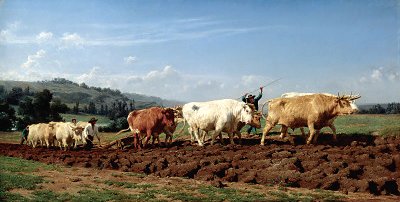 |
|
LABOURAGES NIVERNAIS
SN 433
by Rosa Bonheur
By: Helen Gokbudak, Docent. Date: April 11, 2000
1. Description for the “Awe Inspired Neophyte” leading to “Art
Motivated Novice”
|
This painting is a daylight scene showing two teams of oxen plowing a field. Each team
includes three pairs of oxen and is attached with chains to each other and the plow. There
is a man holding each of the plows and a man holding a prodding-stick on the left side of
each of the teams. The color of the sky is pale blue with white puffy clouds, more clouds
on the left than on the right, the sky is in the upper third of the picture. The teams of
oxen are walking to the right with the freshly turned earth beneath them. The green grass
and unplowed earth are in the forefront of the painting. There is a hill with trees
visible to the left third of the painting.
The first team of oxen to the right is larger and is in the forefront of the painting,
the team of oxen following is smaller giving the perspective of being further away and
also of making a turn to the left.
The men plowing have brimmed black hats, pants and long sleeved shirts, facial features
are not distinct. The first man holding the prodding-stick has a black brimmed hat, with
pants and long sleeved shirt. The second man holding a prodding-stick with the second team
of oxen has only the shoulder and head visible, he has a dark red beret in place.
The oxen vary in color from white, beige, as the first two and then, white and beige,
brown and tan, the last four oxen are small and are whitish in color. The fur and folds of
the skin are very natural in appearance. The horns, eyes, facial features and musculature
of the animals give an impression of reality and of movement. The shadows on the animals
and on the earth demonstrate that the lighting is coming from the left. The freshly plowed
earth is in clumps and shining with freshly turned earth color, this is in contrast to the
forefront of the picture with the grass green and earth flat and brownish in color.
This is a horizontal painting showing the movement of the oxen plowing the field, from
left to right of the canvas. The facial features of the oxen are distinct whereas the men
working do not have distinct facial features. The painting is oil on canvas and is 52.5
inches x 102 inches, the artist’s name and date of 1850 are on the right lower corner
of the canvas. The frame is gold colored and has the name of the artist , Rosa Bonheur, in
the upper middle of the frame, and the title of the painting, Labourages Nivernais, in the
lower middle of the frame.
II. Description for the Advanced Amateur
Rosa Bonheur was a nineteenth century French artist, born in 1822 and died in 1899. She
painted images of animals in naturalistic landscapes with scientific accuracy and a
fidelity to direct observation characteristic of the movement known as Realism.
She studied under her father, an artist, who was part of the utopian socialist
Saint-Simion movement: a movement supporting the complete equality of women with men and
the idea of a society based on love.. At the age of 11, her mother died, and she was given
the responsibility for the care of her three younger siblings. As part of her art
education ,she copied paintings from the Louvre, mostly the Dutch masters including Paulus
Potter, an animal painter, who specialized in cattle and sheep.
In 1848, animal painting as an offshoot of realism and landscape painting became popular
in France. The government of the new Second Republic of France encouraged the landscape
and animal painters and Rosa received a commission from the state for a painting on the
subject of plowing. Plowing in Nivernais was inspired by a novel by George Sand called the
The Mare au diable, Devil’s Pond., which described the lives of peasants and the
cycles of nature. The French Revolution had established the idea of the importance of the
individual, fostering a trend toward originality. It had swept away the patronage system
by suppressing the clergy and dispersing the nobility, the artist was left free to paint
as he chose. In 1852, she obtained official permission to wear men’s clothing so she
could study animal anatomy in the slaughter houses of Paris.
The French Government commission “Labourages Nivernais” or Plowing in Nivernais
was completed in 1849 and brought Rosa Bonhuer further critical and popular acclaim when
exhibited at the Salon. This painting is in the Muse’e d’Orsay, Paris, and is
68.1inches x 102.36 inches. There are two other versions of this painting: one at the R.W.
Norton Art Gallery in Shreveport, LA; and the other painted in 1850 is at the Ringling
Museum and is 52.5 inches by 102 inches. It is stated that there are differences in the
size and in the left background. but details are not given.(Shriver, Rosalia, 1982,p.29)
She was the first woman artist to be honored with the highest award of the French
government, the Cross of the Legion of Honor. The empress of France presented the medal to
her in her studio in 1865. She painted Buffalo Bill Cody and Wild West Show performers in
1889,when they visited Paris. It has been stated that John Ringling would refer painters
for the Circus to study Rosa Bonheur’s paintings.
COLL: Viscount Hambledon; sold at Christie‘s, London, March 1929, No. 177.
Another version of the same composition signed and dated 1847 is in the Musee du
Luxembourg, Paris.
(Suida)
|
